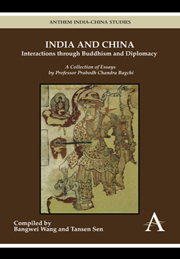 India and China: Interactions through Buddhism and Diplomacy
India and China: Interactions through Buddhism and Diplomacy Introduction (English and Chinese)
Published online by Cambridge University Press: 05 March 2012
Summary
The 2,000 years history of interaction between India and China has been an outcome of the immense contributions made by a number of prominent personalities. Among them, from the Chinese side, we know the names of Faxian, Xuanzang and Yijing. From the Indian side, the names of Kumārajīva, Buddhabhadra, Pāramārtha should be mentioned. Of these renowned monks, Kumārajīva was perhaps the most remarkable. Kumārajīva's father was an Indian and his mother was a princess from the ancient kingdom of Kucha. Since Kucha is now within the territory of China, we may say Kumārajīva was half-Chinese or a Chinese Indian. The various accounts of the life and work of these great historical figures have left deep impressions on our minds.
In modern times, the name that requires special mention in the development of Sino-Indian rapport is Gurudev Rabindranath Tagore. His visit to China in 1924 was an important event in the interface between modern China and India. It rekindled the mutual exchanges between these two nations and propelled the development of a new genre of literary writing in China.
It is noteworthy, at this point, that all these personalities, who tried to bring the two countries closer, were extraordinary scholars with great knowledge and wisdom. Their intellectual acumen and academic achievements played a crucial role in shaping Chinese and Indian cultures and their subsequent intermingling.
- Type
- Chapter
- Information
- India and China: Interactions through Buddhism and DiplomacyA Collection of Essays by Professor Prabodh Chandra Bagchi, pp. ix - xviPublisher: Anthem PressPrint publication year: 2011


